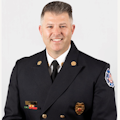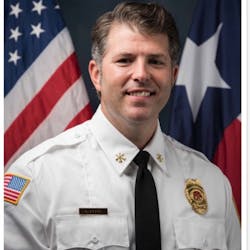If you ever caught yourself breaking off into song to the toe-tapping beat of the age-old hymn, “Will the Circle be Unbroken,” then you are my kind of person. Bluegrass music has a unique history of vocal harmonies with multiple parts, diverse string instruments and lyrical prose that’s moved by emotion, storytelling and deep sentiment that resonate in the rhythm of life’s challenges and joys. In bluegrass, the notes are anticipated, which creates a higher energy as the diverse instrumentation provides unity within the uniqueness of individuality.
What does this have to do with looking through the lens of lady leadership in the fire service? Let me work backward, so we can grow as leaders to listen more to lead within, so we can lead throughout.
Gender bias comes in explicit and subtler forms. Highly skilled women are pressured to succumb to stereotype-driven expectations, which can be discouraging, limiting and damaging. It is a vicious cycle, but the circle can be, and must be, broken. For us to better understand and be inspired for change, we must look at the joys, challenges, assumptions, perspectives and career paths through the lens of our lady leadership in the fire service.
History of heroines
Women have been firefighters for more than 200 years. The first woman firefighter on record was Molly Williams, who was a slave in New York City and a firefighter for Oceanus Engine Co. 11. In 1818, Williams took care of the volunteers in the fire station, cooked, and cleaned the hand-pulled water pumper in addition to learning how the equipment operated. According to FDNY history, one day when the all-male crew was sick with the flu, the bell sounded, and Williams sprang into action and took the pumper to the fire in a devastating winter blizzard as the only healthy firefighter able to go. The word spread quickly that Williams was “as good a fire laddie as many of the boys.”
We can learn from Williams—and countless others—on how to lead with fervor, fortitude and faith to break the circle of stereotypes and presuppositions.
Through the correct lens
Let me preface this next section by explaining that I am not “mansplaining.” I am taking information from research, volunteered perspective from women firefighters and explanation through their lens, to break the circle and improve equality and equity through empowerment and change.
In 2008, the “National Report Card on Women in Firefighting” by the International Association of Women in Fire & Emergency Services, or Women in Fire, examined the inclusion, acceptance, training, testing, and promotion of women in fire and emergency services. The study identified key factors that could be barriers, such as inadequate firehouse living conditions, discrimination, harassment and unfair promotional processes.
In another study regarding workplace culture, particularly women firefighters, and the effect of female injury rates on the fireground, the author identified occupational experiences for women, such as physical demands, gender-related physiological differences, earning respect, negative attitudes of male counterparts, compensatory strategies and equipment maladaptation, as thematic findings that contribute to higher injury rates. Better understanding how women differ from their male counterparts in size, stature and training requirements will allow for advances in training and equipment and increased female recruitment and retention. It also will lead to decreased time away from the job as a result of injury and decreased injury costs for fire departments.
In a recent questionnaire, some women firefighters shared perspective in a number of areas, such as proving oneself, challenges that they face as a leader, advice to give a new woman firefighter/EMT, how resiliency propelled them along in their career and what makes women in the fire service unique as leaders. The rhythm of responses shed light on necessary change that capitalizes on diversity while providing unity within the uniqueness of individuality, just like that bluegrass sound. Below are thoughts that emerged from some of the responses, which should enlighten and empower all of us.
- Don’t give special treatment based on gender where negative prejudice results in “labeling” the abilities of others. Explain when necessary but don’t demean through ignorant assumptions.
- When it comes to the learning or practicing of a skill, you can give a woman firefighter pointers and advice on how she can improve but don’t consistently and completely take over any tasks to which she is new and trying to accomplish, because then she will never learn how to get them done. Train women firefighters like one of the other guys.
- A woman firefighter’s physiology doesn’t prevent her from getting the job done. It just means that she doesn’t always get it done the same way as the average man. Her goal is to become a great firefighter period, not just “good enough for a girl.”
- Women firefighters must go to work and prove themselves every day, regardless of gender, because lives depend on their actions, knowledge and wisdom.
- For supervisors specifically, talk to new women firefighter/EMTs about fire service culture and how to set the record straight that she is there to work and to know that in a dating scenario, relationship decisions will follow her longer than they will follow a man in the department
Fight fire like a girl
Phrases such as “you fight like a girl” and “you throw like a girl” demean the power, control and ability of women, as if men are superior beings and being a girl is a bad thing. On the other hand, to “fight fire like a girl” takes tenacity, willpower and courage to overcome adversity and stereotypes in a traditionally male-dominated profession. What was it that made Molly Williams unique as firefighter? Was it her gender? Was it the “times?” Was the fire triangle different in 1818?
Equality, equity and opportunity give access and support to all with proportional representation to achieve fairness of outcomes, therefore breaking created circles and allowing for strength through diversity and inclusion. I am empowered to “fight fire like a girl” by looking at the joys, challenges, assumptions and perspectives through the lens of our lady leadership in the fire service to learn, so I can better lead within to lead throughout, by being the change that the fire service needs.
“Will the Circle be Unbroken” is an anthem of hope, perseverance and life in the face of adversity. Until women are represented equally in the fire service, it’s natural that they’ll feel anxiety as they settle into their careers, but that anxiety shouldn’t be crippling. With leadership support and cultural change, women must be equally represented in the fire service, as all firefighters should be encouraged to “fight fire like a girl,” with tenacity, willpower and courage, just as Molly inspirationally answered the bell.
About the Author

Dr. Brett Ellis
Dr. Brett Ellis is a 27-year veteran of the fire service and serves as the fire chief for the city of Webster Groves, MO. He holds a bachelor’s degree in fire administration from Western Illinois University, a master’s degree in leadership and adolescent development from Huntington University and a doctorate in education from Concordia University-Portland. As a consultant (AGILE Leadership Consulting Inc.), Ellis focuses on leadership, firefighter behavioral health, conflict resolution, officer development, organizational movement, relationship building and personnel role plays that are based on fire service lawsuits. As well, he teaches for the National Fire Academy and Columbia Southern University.
